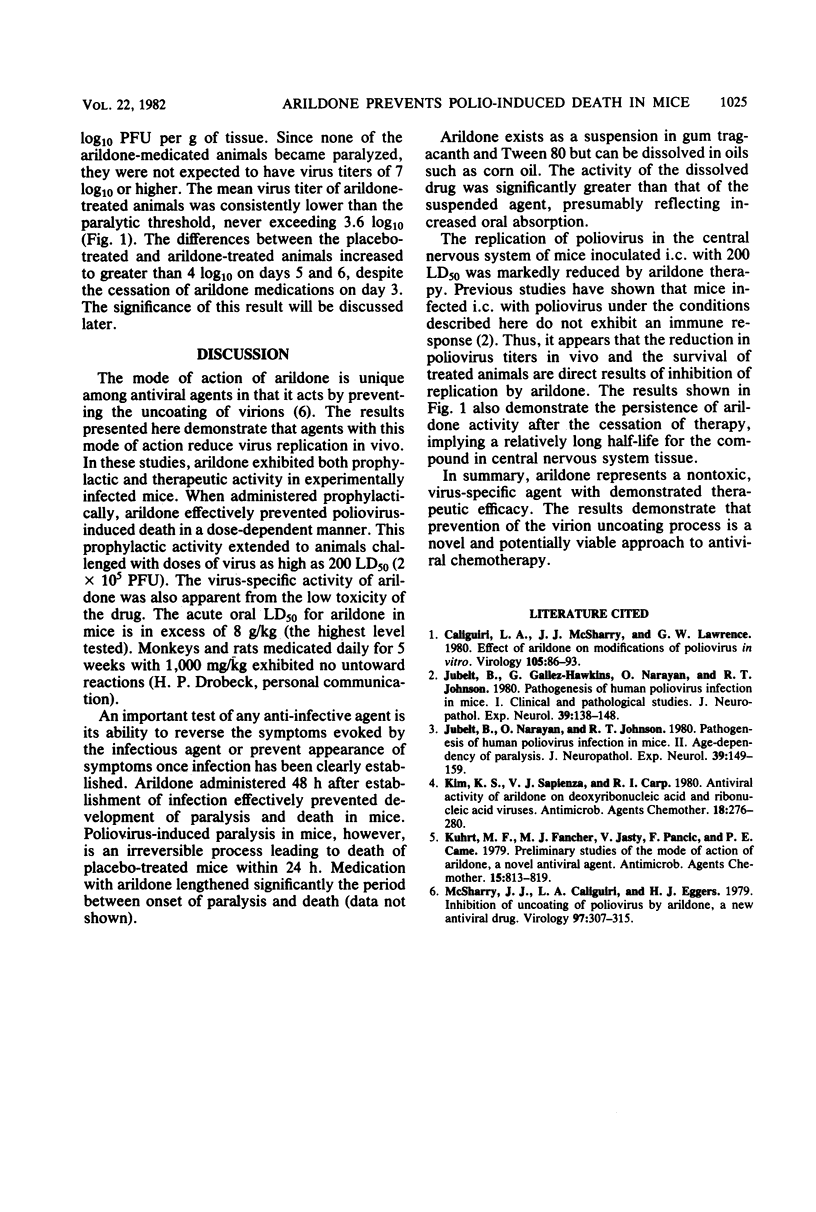Abstract
Arildone, a novel antiviral agent which blocks virion uncoating, was assessed for its ability to prevent paralysis and death in mice infected intracerebrally with a lethal dose of human poliovirus type-2 (strain MEF). Intraperitoneal administration of arildone suspended in gum tragacanth prevented paralysis and death in a dose-dependent manner (minimal inhibitory dose = 32 mg/kg, twice daily) and protected animals from virus challenges in excess of 20 50% lethal doses. Oral medication with arildone solubilized in corn oil was similarly effective in preventing poliovirus-induced paralysis and death. Arildone was therapeutically effective even when intraperitoneal medication was delayed for 48 h postinfection. Analysis of the virus titers in the central nervous system tissues of animals infected with 200 50% lethal doses demonstrated that arildone reduced titers in the brain and spine by approximately 3 and 4 log10 PFU per g of tissue, respectively, implying that direct inhibition of virus replication was responsible for host survival. Arildone is the first antiviral agent capable of preventing poliovirus-induced death in mice. The efficient inhibition of poliovirus replication described here demonstrates the potential usefulness of uncoating blockers in the systemic treatment of viral diseases.
Full text
PDF



Selected References
These references are in PubMed. This may not be the complete list of references from this article.
- Caliguiri L. A., McSharry J. J., Lawrence G. W. Effect of arildone on modifications of poliovirus in vitro. Virology. 1980 Aug;105(1):86–93. doi: 10.1016/0042-6822(80)90158-0. [DOI] [PubMed] [Google Scholar]
- Jubelt B., Gallez-Hawkins G., Narayan O., Johnson R. T. Pathogenesis of human poliovirus infection in mice. I. Clinical and pathological studies. J Neuropathol Exp Neurol. 1980 Mar;39(2):138–148. doi: 10.1097/00005072-198003000-00003. [DOI] [PubMed] [Google Scholar]
- Jubelt B., Narayan O., Johnson R. T. Pathogenesis of human poliovirus infection in mice. II. Age-dependency of paralysis. J Neuropathol Exp Neurol. 1980 Mar;39(2):149–159. doi: 10.1097/00005072-198003000-00004. [DOI] [PubMed] [Google Scholar]
- Kim K. S., Sapienza V. J., Carp R. I. Antiviral activity of arildone on deoxyribonucleic acid and ribonucleic acid viruses. Antimicrob Agents Chemother. 1980 Aug;18(2):276–280. doi: 10.1128/aac.18.2.276. [DOI] [PMC free article] [PubMed] [Google Scholar]
- Kuhrt M. F., Fancher M. J., Jasty V., Pancic F., Came P. E. Preliminary studies of the mode of action of arildone, a novel antiviral agent. Antimicrob Agents Chemother. 1979 Jun;15(6):813–819. doi: 10.1128/aac.15.6.813. [DOI] [PMC free article] [PubMed] [Google Scholar]
- McSharry J. J., Caliguiri L. A., Eggers H. J. Inhibition of uncoating of poliovirus by arildone, a new antiviral drug. Virology. 1979 Sep;97(2):307–315. doi: 10.1016/0042-6822(79)90342-8. [DOI] [PubMed] [Google Scholar]


